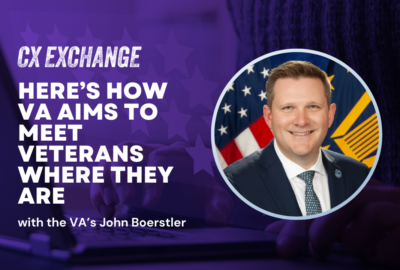Hubbard Radio Washington DC, LLC. All rights reserved. This website is not intended for users located within the European Economic Area.
On Air: Federal News Network
Trending:
Information to strategy: The future transformation of CIOs
Enough with all the talk about whether or not federal CIOs have enough authority, Keith Trippie said. The real conversation is how CIOs and their organization n...
By Keith Trippie
Commentary
What is your image of a chief information officer (CIO)? Quick close your eyes. Can you see them?
Now close your eyes and think of what the CIO looks like in 2020. Do they look the same?
What are the characteristics of a successful CIO of the future?
What skillsets are they looking for in their staff?
What problems are they looking to solve in the future? 
If you have been in IT, or been a CXO peer or even a mission owner for any period of time, I am sure you have some thoughts on the above. Much has been written in media, discussed in conferences around D.C. and knocked around in legislative circles about the right level of authority a CIO should have.
But the CIO authority discussion needs to be less about what is the right amount and more about how the CIOs position themselves to better meet the needs of the agency and deliver value, in an age of digital enlightenment.
Today CIOs spend much of their time with IT focusing on the “T.” From BlackBerrys to servers and firewalls to data centers, your day can easily be consumed with operational realities. The phone rings and you reluctantly unholster it and peek at who is calling. You know it won’t be fun, but you do it. Typical CIOs today are 70 percent-plus IT and less than 30 percent business. No fault of their own, but that was the music that has been playing for two decades now. And when the DJ is spinning Styx’s “Mr. Roboto,” you do the Robot.
I’m not saying that there aren’t some CIOs that are making progress in this space. In fact, I have had the privilege of working with some of the best CIOs in the business. But they too, faced the burden of IT managing you, vice the other way around. And when you spend that much time with silicon, you don’t have time to spend it with the folks that matter the most — customers, leadership, mission peers and lines of business partners.
Fortunately with the rise of ubitiquous IT, smartphones, mobile applications, the Internet of Things, data consumerization, outsourcing IT and those young whippersnappers coming out of college, CIOs will finally be free of the daily grind. But what will CIOs do with this found time in the new world?
The future for CIOs will be one made up of by new roles and responsibilities.
Days of help desk calls and troubleshooting the latest IT bump in the road as part of the daily activity are dunskie. The CIO is no more. Gone the way of the chimney sweeper, no offense to the Dickens fans in the audience.
What I see for the CIO of the future — the chief strategy officer (CSTO).
It doesn’t exist today, but that position will develop over the next 5-to-10 years. This is bold but necessary evolutionary step to help the government transform into a customer-centric, business focused entity. The challenges we face today are too complex for 25-year-old paradigms. I view this a less a discussion of authorities CIOs may or may not have today, rather how they and their organizations deliver value.
So who are these future CSTO’s?
The easiest way to think about it is they will flip from IT centric to business centric. That means they will spend 70 percent of their time on the business side and 30 percent on the IT side. They will be more MBA than computer science. Less cost center, more value and revenue centric.
The diversity of thought and background will be required to make this change effective and meet future business challenges.
In the future, if you did a heat map of emails, calendar appointments and phone calls from a typical CSTO, you would see large heat signatures around mission executives, CXOs and leadership, with small heat footprints around traditional IT staff and traditional IT peers. The new chief strategic officer will be accountable to ensure services are meeting business objectives, but won’t be responsible for traditional IT day-to-day.
So who will be responsible for managing all this IT day-to-day work in the future? Industry.
They do it today for Fortune 500 companies, small businesses and international organizations. Let’s face it, they do most of it for the government today with federal staff providing oversight. So I don’t think there is much change here, other than a mindset shift and well crafted, performance-based contracts. We have to let the day-to-day grind go the way of the horse and buggy.
So now our chief strategic officer’s time is freed up, what will they do?
First and foremost, their days will be spent working with business, mission and CXO peers on providing solutions to meet tomorrow’s challenges. The chief strategic officer will be firmly embedded in governance forums spanning the planning, budgeting, programming and execution (PPBE) functions of an organization.
They will work with policy, CFO and mission executives on developing the organization’s strategic outcomes. Every spring and summer they will work with those aforementioned executives on resourcing to ensure financing is appropriately aligned within the agency to meet strategic outcomes, leveraging a portfolio management framework. During the execution phase, they will be the co-chairman of acquisition/program governance forums to review performance of agency investments. And finally they will be a critical component of the feedback loop to ensure the link between program performance, and agency planning and resourcing for out-year budget requests. I like to call this, the line of sight across the PPBE.
The chief strategic officer will have to fully understand the business objectives of their agency, have keen business acumen to identify where gaps in performance exist, de-fund IT investments that are not producing results, work with the CFO and Leadership on the appropriate portfolio of investments on where to re-invest the funding and embrace innovation as a key tool in their tool belt.
And they will spend a lot of time out in the field with agency staff providing services directly to the public and other agencies. Whether that time is spent at a service center, a port, at an embassy or ride-alongs with law enforcement officers, the action is out “there.” Some CIOs are able to get out there today, but unfortunately that time is limited with the day-to-day IT needs back at the office. To truly understand the mission and provide enhanced value, time must be committed to the field.
What will the CSTO’s staff look like?
What skill sets will they need to help the CSTO achieve their mission?
This new organization and chief strategy officer cannot hire the status quo. To achieve the above, there is a whole new talent base that has yet to be tapped across the federal space.
The office of the CSTO will need to hire customer service talent from the private sector and bring on customer service organizations to help train the staff. Let’s knock on the door of a few large retailers, guest services executives from large hotel or sports franchises and see if we can entice them to apply their tradecraft within the government space.
Other key talent will come from business and strategic analysts. These folks are key to bridging the gap with the mission executives delivering services to citizens. A burgeoning profession, but in short supply in the federal space, are data scientists. These people are not the traditional data analysts and architects. Rather these people specialize in the sweet spot of data. The economics of data and how data across completely different missions, business functions, commercial and federal data, can be quickly correlated to help achieve business outcomes through fact based data driven decisions.
The OCSTO will need strong financial analysts. And not your standard fare IT financial analysts. Rather I envision a recruiting pipeline into Wall Street and hedge funds and let’s get the folks who analyze investments within a portfolio management framework. I would also envision very specialized contracts specialists that have extensive background in buying mobile, cloud and operational technology with security built into the product before it comes off the assembly line.
Agencies will have lots of talented individuals to choose from within the commercial space, as they are already buying these capabilities today in the commercial space. Finally, I envision hiring risk analysts. Let’s raid the insurance cupboards. They are the pros and plenty of them available to help drive change in the federal space spanning investment strategies and cyber, just to name a few.
Lastly, let’s go find some people that are leaders in the commercial mobile space. There are tens of thousands of them out there. Customers want value and that is at the business layer. And who are the preeminent thought leaders in this space, mobile developers. Within weeks, these mobile ninjas can develop high value apps that are available wherever the users are to help them make money, save lives, redefine private transportation logistics, etc. The government could use that talent to greatly benefit citizen services.
Hmm, don’t see system administrators or network specialists listed above. You are right. They aren’t there, at least not as feds. Those are outsourced targets within industry.
The above recommendations are not for the faint of heart. Change is hard, I get it. But I would challenge, if not now, then when.
I had the opportunity a few years back to visit a large financial organization to discuss how that organization leverages IT to maximize revenues, increase productivity of their analysts, enhance customer service and gain operational efficiencies. It was a great discussion.
But my main takeaway was where the CIO’s office was in relation to the chief executive’s office. How many floors down from the CEO was said CIO, and what small office did they sit? None. This CIO sat just two doors down from the CEO, in a beautiful office overlooking the Hudson.
Where will your agency’s CIO sit in 2020?
Keith Trippie, a former Senior Executive Service member, left the Homeland Security Department in March after spending 11 years in government. The last position he held at DHS was as the executive director for the Enterprise System Development Office within Office of the Chief Information Officer. He’s now the CEO of The Trippie Group.
Copyright © 2024 Federal News Network. All rights reserved. This website is not intended for users located within the European Economic Area.
Related Topics




